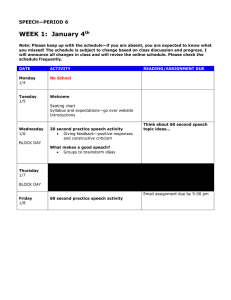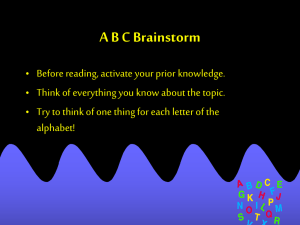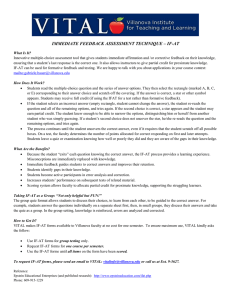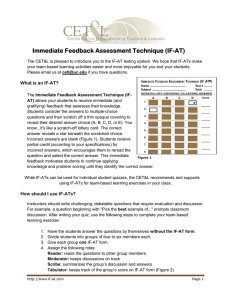Christine Harrington’s Session 2: Success with the Frist Day of... Creative first-day activity ideas:
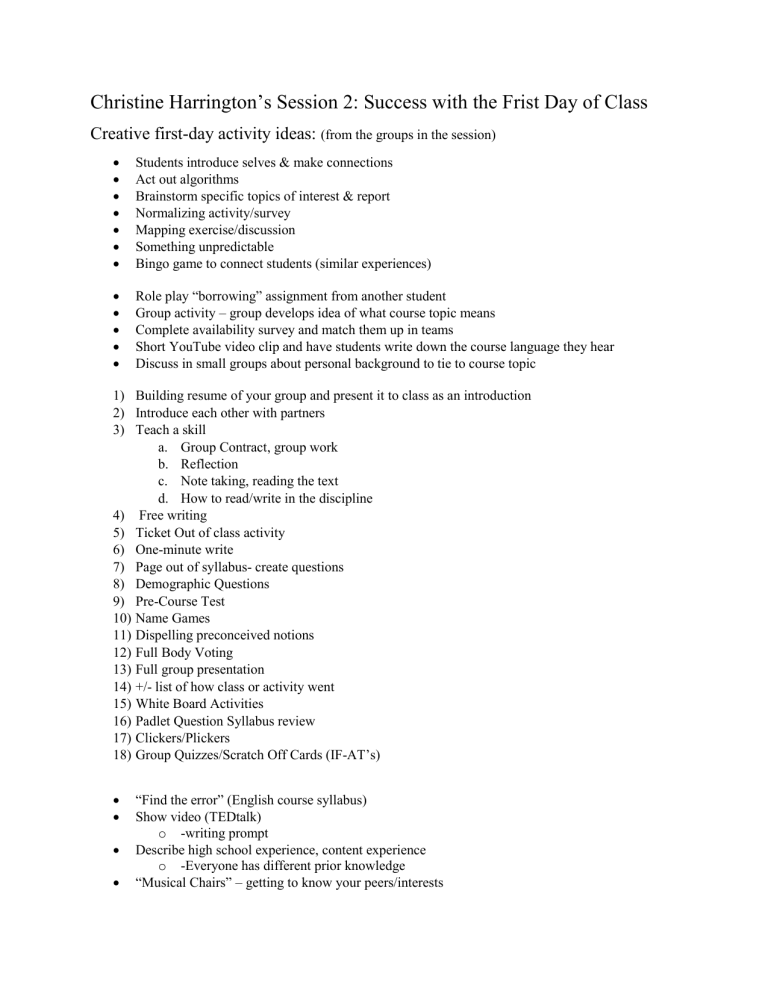
Christine Harrington’s Session 2: Success with the Frist Day of Class
Creative first-day activity ideas:
(from the groups in the session)
Students introduce selves & make connections
Act out algorithms
Brainstorm specific topics of interest & report
Normalizing activity/survey
Mapping exercise/discussion
Something unpredictable
Bingo game to connect students (similar experiences)
Role play “borrowing” assignment from another student
Group activity – group develops idea of what course topic means
Complete availability survey and match them up in teams
Short YouTube video clip and have students write down the course language they hear
Discuss in small groups about personal background to tie to course topic
1) Building resume of your group and present it to class as an introduction
2) Introduce each other with partners
3) Teach a skill a.
Group Contract, group work b.
Reflection c.
Note taking, reading the text d.
How to read/write in the discipline
4) Free writing
5) Ticket Out of class activity
6) One-minute write
7) Page out of syllabus- create questions
8) Demographic Questions
9) Pre-Course Test
10) Name Games
11) Dispelling preconceived notions
12) Full Body Voting
13) Full group presentation
14) +/- list of how class or activity went
15) White Board Activities
16) Padlet Question Syllabus review
17) Clickers/Plickers
18) Group Quizzes/Scratch Off Cards (IF-AT’s)
“Find the error” (English course syllabus)
Show video (TEDtalk) o -writing prompt
Describe high school experience, content experience o -Everyone has different prior knowledge
“Musical Chairs” – getting to know your peers/interests
Introduction and ask the previous person a question about themselves
Introduce someone else – find a unique piece to share with class
Share prior experiences
Pair discussions (large lecture)
1.
Talking circle passing around an object to make students feel more “at ease” when they speak
2.
Fill our “student goal sheet” of their future goals even after end of class
3.
Pre-test (followed by post-test) on course content. Then go through it and discuss answers later
4.
Concept Map: map what it would look like to achieve a certain goal.
5.
Myth Busting Activities: students all write down their preconceived notions of course/discipline and then groups talk about what others wrote.
6.
Make lists of what students know and what they need to know about course content.
7.
Watch “TED Talk” and talk about: what do you agree with, what don’t you agree with, and why did we did we watch this?
8.
Challenge students to “unpack” concept that they have never had to think about before.
9.
Do introductions by having students sit or stand in circle and look at each other when speaking.
Creative First Day Activity Ideas
5.
6.
7.
8.
1.
2.
3.
4.
Use iPad to learn an App and then introduce themselves to the group using the App
Two Truths and a Lie about the instructor
Learn the SEE alphabet and they introduce/spell their names to each other in sign
Animate an analogy to explain stuttering (or other disorders/conditions)
Start and contribute to the class Pinterest site adding resources/links
Add a page to a class Weebly site
Add to a class blog (or an Ask Me Anything) with questions to the instructor
Students or small groups create screencasts together (related to sharing of self or course content)
9.
Write job descriptions
First Day Activities
· In large lecture courses you can have them write things on cards, pass them to the front, mix them up, and then pass them back out (saves times in large lecture courses).
· Clicker Quiz on diversity; it shows the types of diversity that are very apparent in Wisconsin that aren’t necessarily apparent to all people in the class.
· Pick an activity that shows them that they all have some relevant knowledge (even though they might not think they do; e.g. Why do rivers not stop flowing? Why do the seas not rise?). Ask them to draw out the water cycle later (because they likely are aware).
· Students can usually report on problems they see with issues (such as politics), ask students to highlight problems and then as a class brainstorm solutions (or talk about where you will talk about solutions).
· Define 4 terms that we are going to focus on in the class and then present on what we are talking about. You could come back to these at the end of the semester!
Contact CETL if you want to discuss any of these ideas or if you want even more!!!!
CETL@uwec.edu
715.836.2385 1142 Old Library
